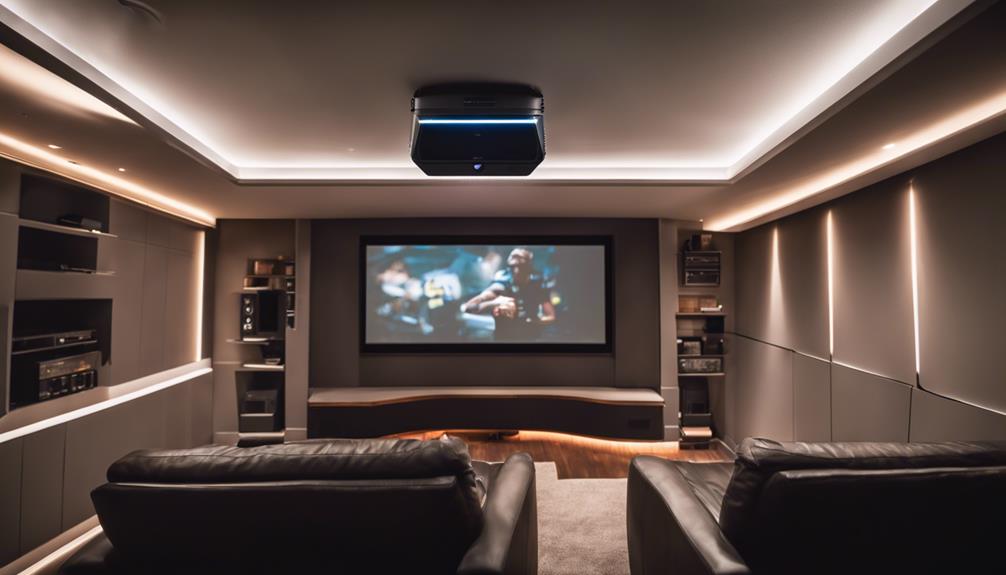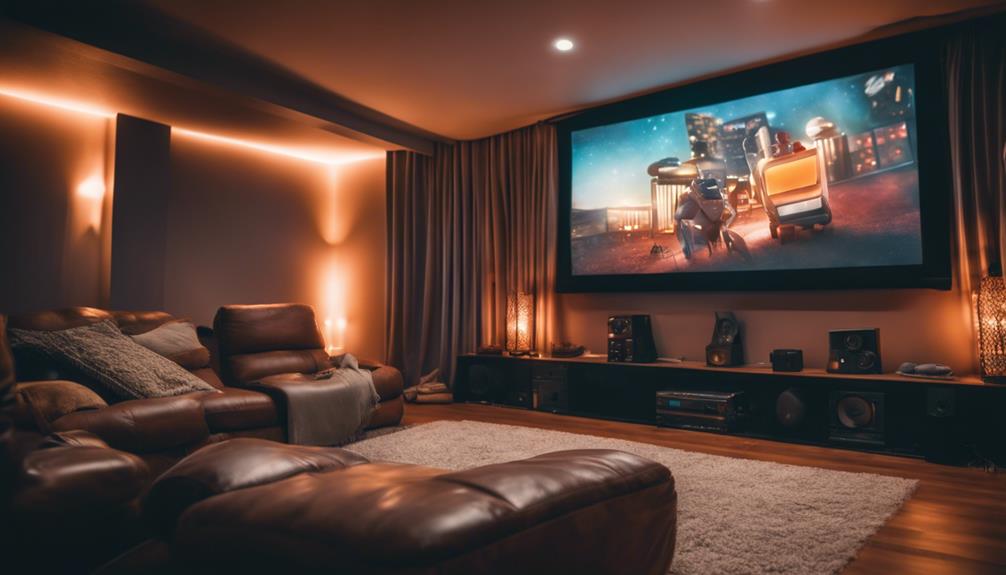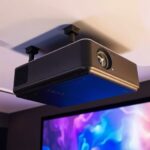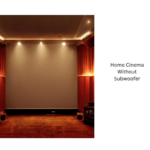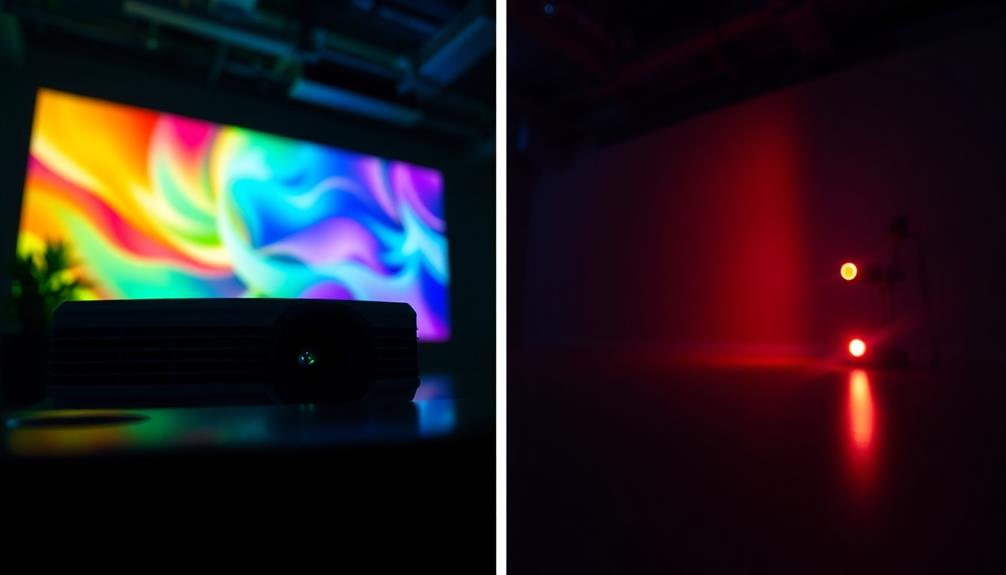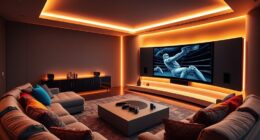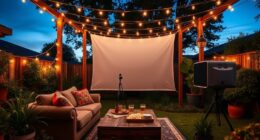When deciding how to mount your projector, consider ceiling, wall, or shelf options. Ceiling mounts offer a clean look and save floor space, making them ideal for dedicated home theaters. Wall mounts may limit accessibility, but can blend with decor. Shelf mounts provide easy maintenance access and are typically cost-effective. Make sure to install securely to avoid stability issues, especially in high-traffic areas. Position the projector at the right height—18 to 40 inches above the floor—and prioritize ventilation. Each choice has distinct benefits, and exploring these options in detail can help you make the best decision.
Key Takeaways
- Ceiling mounts provide a cleaner look and better throw distance but may complicate maintenance due to height accessibility.
- Shelf mounts allow for easier maintenance access and can blend with room decor while requiring careful height consideration for optimal image quality.
- Wall mounts can save floor space but may limit easy access for servicing and adjustments, making maintenance more challenging.
- Use vertical lens shift for flexibility in projector placement to minimize keystone adjustments regardless of mounting type.
Installation Considerations
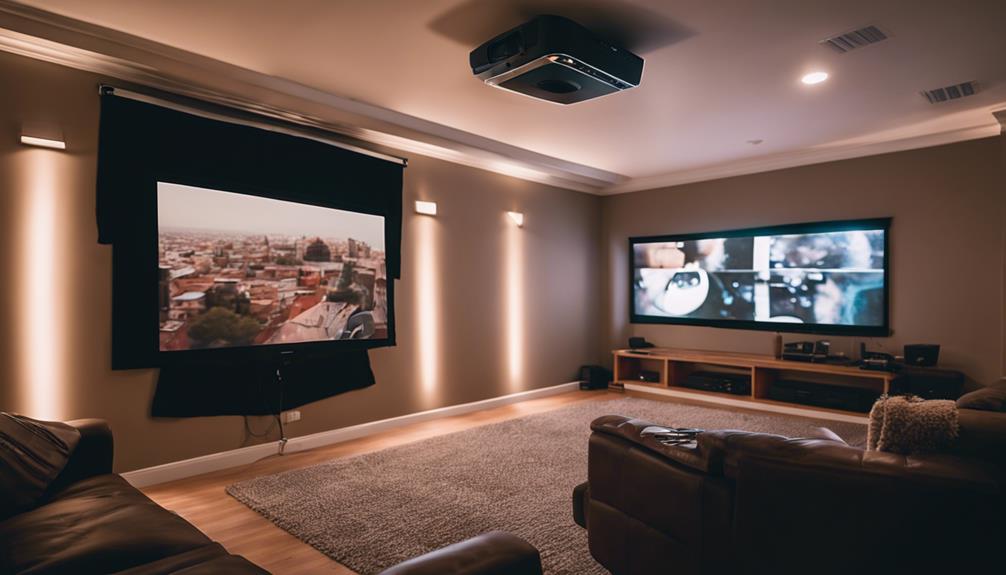
When mounting a projector, you need to take into account factors like ceiling height and orientation to guarantee excellent installation and image quality. The installation method you choose may depend on whether you're mounting the projector upside-down or right-side-up. If you're opting for an upside-down mount, a ceiling mount is crucial. On the other hand, right-side-up installations may work well with shelves.
Be mindful of ceiling height and shelf placement, as they directly affect the projector's throw distance and the necessary keystone adjustments. A higher ceiling can improve throw distance, while lower ceilings might require precise adjustments to maintain ideal image quality. Secure fastening to the hat channel is essential for both ceiling mounts and shelves to guarantee stability during use.
Additionally, weather delays can impact your installation timeline, especially if drywall work needs to be finished first. Consider installing a sturdy base, like wood, to provide solid support for your projector. With these installation considerations in mind, you'll set up your projector effectively and enjoy a high-quality viewing experience.
Aesthetic and Functional Preferences
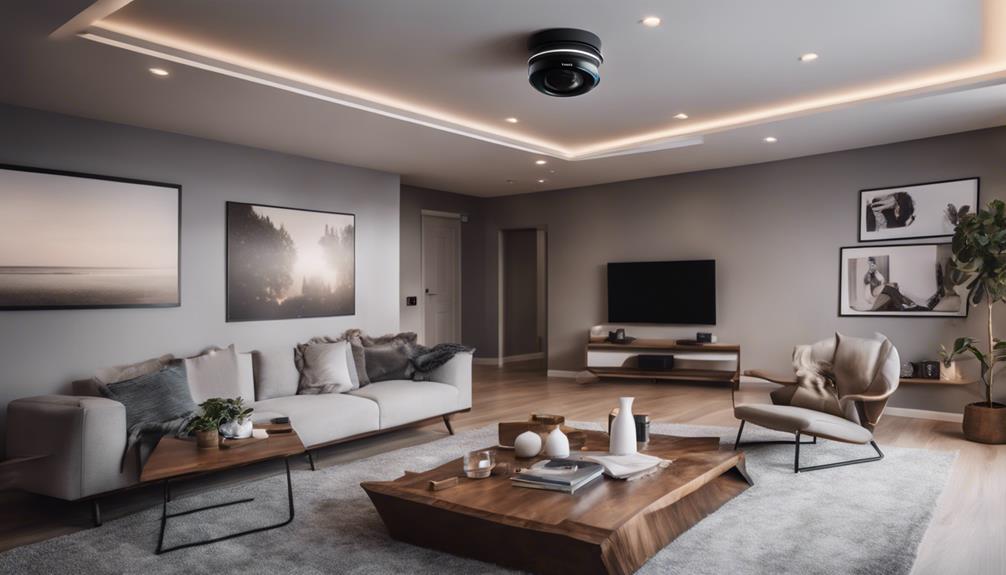
Choosing the right mounting option for your projector hinges on balancing aesthetic appeal with functional needs.
If you value aesthetic preferences, shelf installation might be your best bet. It seamlessly integrates with various room designs and provides easy maintenance access, making it a practical choice.
On the other hand, ceiling mounts are popular because they offer a cleaner visual appearance and maximize your viewing space by reducing floor clutter.
However, it's crucial to evaluate the functionality of your setup. Depending on your room layout and projector specifications, you may find that the practical benefits of one option outweigh its aesthetic drawbacks. Securely installed shelves can deliver the same functional advantages as ceiling mounts while enhancing the overall room decor.
Ultimately, personal taste plays a significant role in your decision. You'll want to align your installation choice with your style preferences and the visual appearance of your space.
Think about how your choice complements your overall room decor, ensuring you create an environment that's both stylish and functional.
Projector Specifications
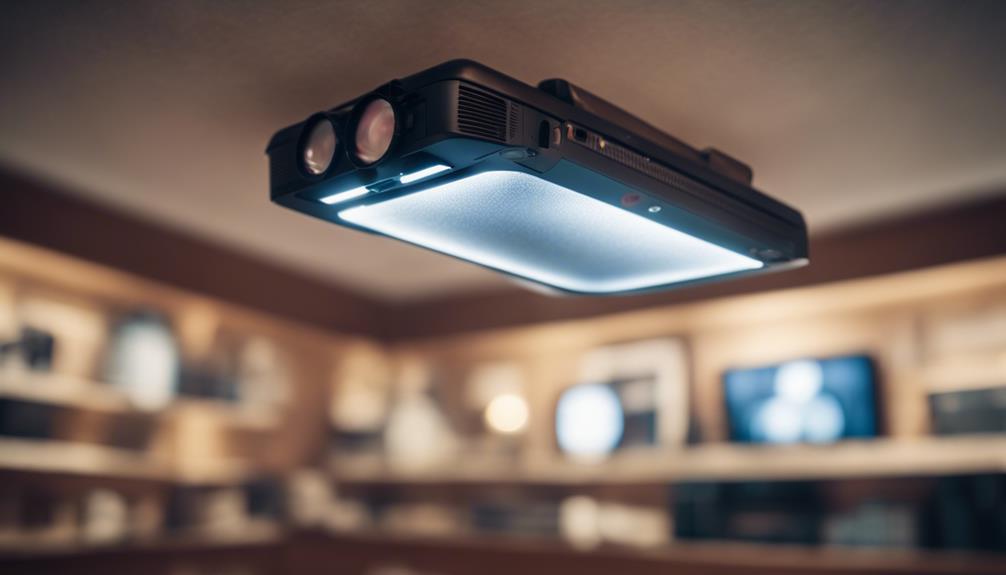
When choosing a projector, you need to take into account its lens shift capabilities and size.
These specifications can greatly affect where you can mount the projector and how well it aligns with your screen.
Additionally, the projector's best placement can enhance the viewing experience, especially when combined with a well-designed home theater setup.
Understanding these factors will help you make an informed decision for ideal viewing.
Lens Shift Capabilities
How does lens shift capability influence your projector installation options? It greatly impacts how you can mount your projector while ensuring peak performance.
With adjustable vertical lens shift, you gain flexibility in positioning your projector above or below the screen, reducing the need for keystone adjustments. This allows you to maintain image quality even when shelf height varies.
Here are some key points to reflect on:
- 3LCD projectors: Generally feature adjustable vertical lens shift, perfect for shelf mounting.
- DLP projectors: Often lack this capability, limiting your installation options.
- LCoS projectors: Brands like JVC and Sony offer vertical lens shift, enhancing installation versatility.
- Non-adjustable projectors: Require precise shelf height (18 to 40 inches) for peak performance.
Projector Size Considerations
Considering the size and weight of your projector is essential for guaranteeing a secure and effective installation. Heavier projectors require more robust mounting solutions to prevent accidents and guarantee stability.
When selecting installation methods, always consider the projector type, as it can greatly affect throw distance and image quality. If your projector features adjustable vertical lens shift capabilities, you'll find it easier to achieve ideal positioning, whether you choose to mount it on a shelf, wall, or ceiling.
Adhering to the recommended mounting height is also important; for example, some models like JVC suggest a shelf height of 18 to 40 inches above the floor for best performance.
Larger projectors may need reinforced mounting hardware, so don't overlook this aspect during installation. Also, remember that the throw distance varies based on lens specifications, which impacts how high and at what angle you should mount the projector.
Stability and Safety
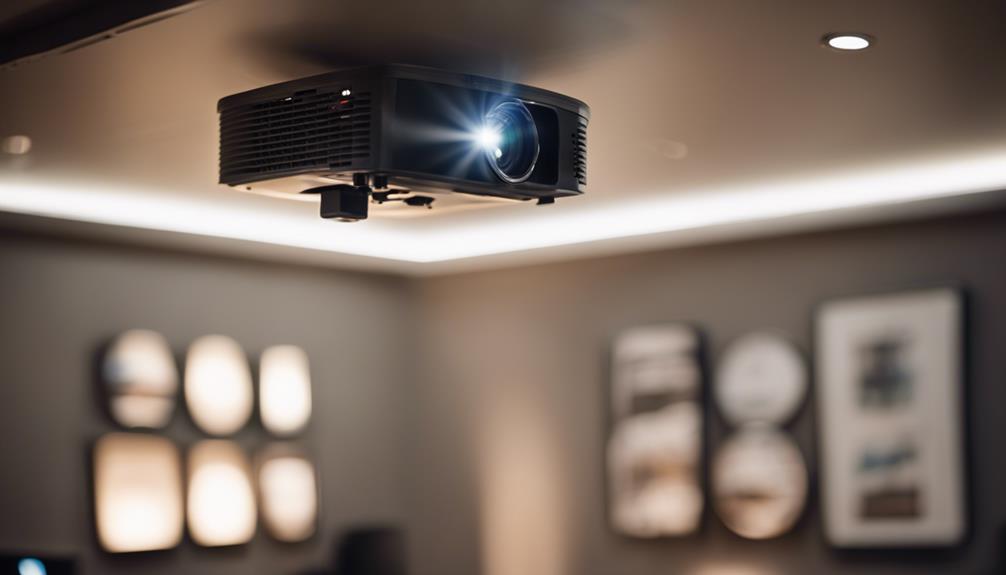
Guaranteeing your projector's stability and safety is essential to prevent accidents and protect both the equipment and those nearby. You need to choose the right mounting option and verify it's properly secured. Here's what to take into account for maintaining stability and safety:
- Choose sturdy projector mounts: Whether you opt for ceiling mounts, wall mounts, or shelf-mounted options, confirm they can handle the projector's weight.
- Install ceiling mounts correctly: Make sure they're fastened securely to prevent any risk of falling.
- Utilize sturdy shelving: If you're going shelf-mounted, opt for well-constructed shelving that can support the projector's weight without collapsing.
- Regular maintenance checks: Periodically inspect installation points for wear and tear, especially in high-traffic areas or places prone to vibrations.
Community Insights and Experiences
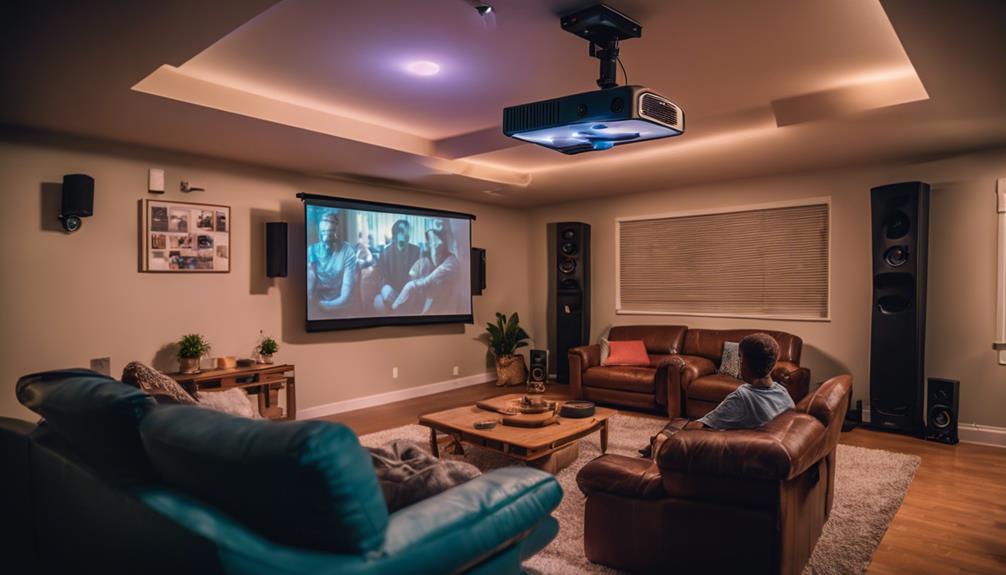
Community feedback highlights diverse preferences and experiences when it comes to mounting projectors, with many favoring ceiling mounts for their superior image quality while others appreciate the accessibility of shelf setups.
Users in dedicated home theater environments often choose ceiling mounting due to its ideal throw distance, which enhances luminosity and delivers a crisp image. Conversely, those who opt for shelf mounting enjoy easy maintenance access, allowing for quick filter cleanings and lamp replacements without the hassle of climbing a ladder.
Stability is a significant concern in community discussions, particularly for installations in high-traffic areas. Many users report that properly installed shelf mounts can provide adequate support, especially when constructed with care.
Aesthetic preferences also play a role, as some individuals prefer shelf setups that blend seamlessly with their room decor compared to the more utilitarian look of ceiling mounts.
Mounting Method Advantages
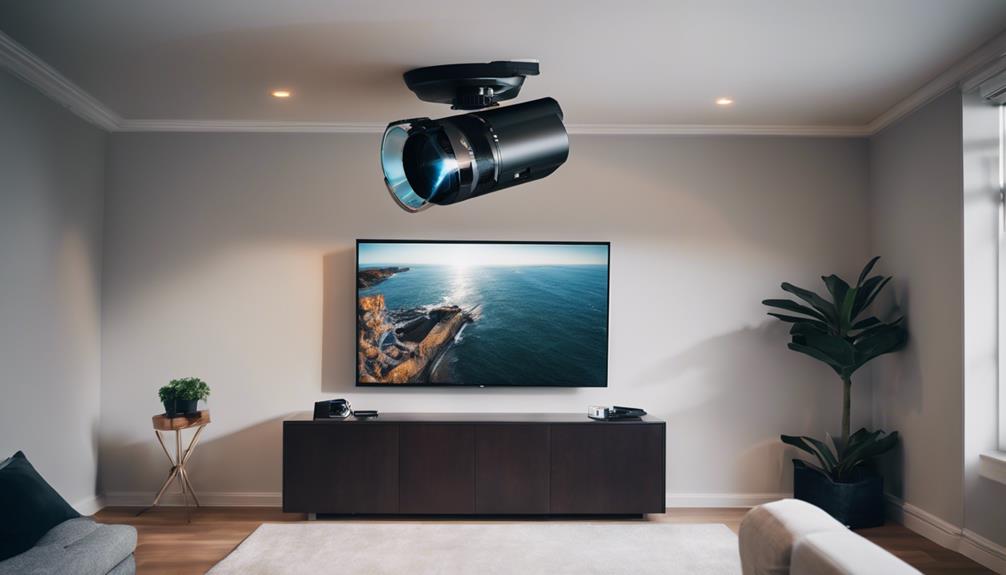
When choosing a mounting method for your projector, consider the advantages each offers concerning cost-effectiveness, accessibility for maintenance, and aesthetic integration.
You want a solution that not only fits your budget but also allows easy access for upkeep and enhances your room's look.
Let's break down these key points to help you make the best choice.
Cost-Effectiveness Comparison
Choosing the right mounting method for your projector can greatly impact your budget, as ceiling mounts often come with higher installation costs, while shelf mounts provide a more economical option.
Here's a breakdown of the advantages:
- Lower installation costs: Shelf-mounted projectors typically require less labor and expertise.
- Cost-effective solution: Projector stands offer flexibility for various setups without permanent installation.
- Reduced maintenance costs: Shelf mounts often allow easier access to projectors, making cleaning and lamp replacement simpler.
- Performance: Investing in a quality shelf mount can yield similar performance to ceiling mounts at a lower cost.
Accessibility for Maintenance
Accessing your projector for maintenance is much easier with shelf mounts compared to ceiling mounts, which can require ladders or special tools.
Shelf mounts are typically positioned at a lower height, allowing you to reach your projector quickly for tasks like cleaning filters or replacing lamps. This enhanced accessibility means you can address maintenance needs without the hassle of complicated setups.
While wall mounts provide solid support, they can still limit your ability to access the projector easily. You'll need to exert extra effort to reach it for servicing.
On the other hand, ceiling mounts complicate matters further, as their elevated position can turn minor maintenance tasks into time-consuming challenges.
Using a projector stand is another great option that not only enhances portability but also simplifies maintenance. You can relocate the projector as needed without disassembling anything, making it easier to perform quick adjustments and troubleshoot projector issues.
Ultimately, choosing the right mounting method greatly impacts how efficiently you can maintain your projector, ensuring it runs smoothly and effectively in any setting.
Aesthetic Integration Options
While maintenance accessibility is important, the aesthetic integration of your projector can greatly enhance the overall ambiance of the room. Choosing the right mounting method can help you achieve a harmonious look that complements your design themes and improves the viewing experience.
- Ceiling Mounts: Offers a clean, unobtrusive look, freeing up floor space and ideal for professional settings.
- Shelf Mounts: Provides greater accessibility, making adjustments and maintenance simple without ladders or tools.
- Design Considerations: Shelf installations can blend seamlessly with other furniture, enhancing your room's overall decor.
- Image Quality: Ceiling mounts allow for closer projector placement to the screen, improving brightness and clarity.
Practical Tips for Shelf Mounting
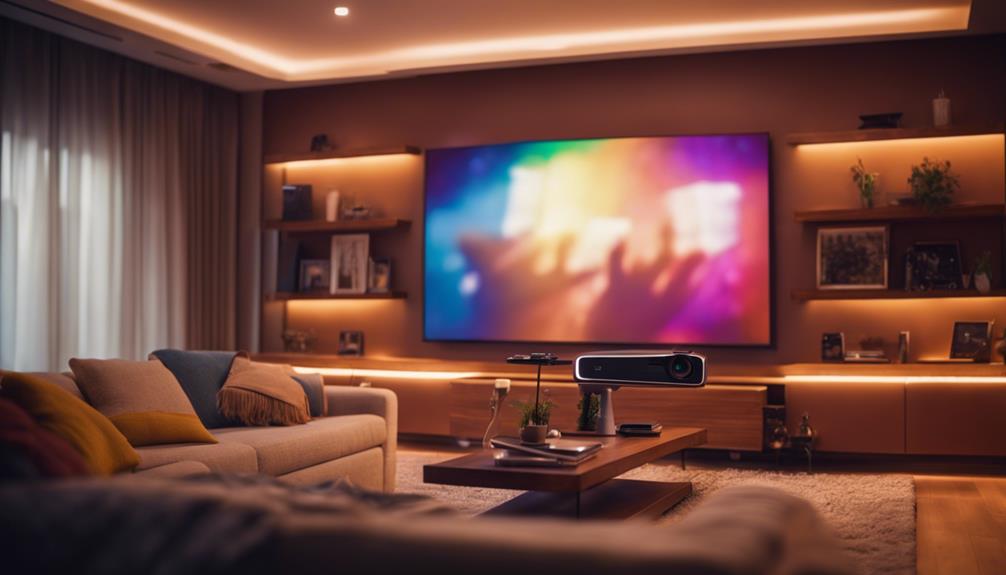
To achieve the best performance when shelf mounting your projector, aim to position it 18 to 40 inches above the floor for ideal image brightness and minimal keystone adjustments.
Using adjustable shelves can help you fine-tune the projector height and alignments, ensuring the lens is level with the screen to maximize effective lens shift performance.
Ensure that you maintain a 5-6 inch clearance at the back of the projector for proper ventilation, preventing overheating during operation.
If your projector lacks adjustable lens shift, consider the room's dimensions and shapes when deciding on projector placement, as this will help avoid ceiling projection and misalignment.
Regularly check and secure your shelf mounts, especially in high-traffic areas or rooms with foot traffic above, to prevent any risks of collapse.
Proper mounting is vital for maintaining safety and performance.
General Recommendations for Setup
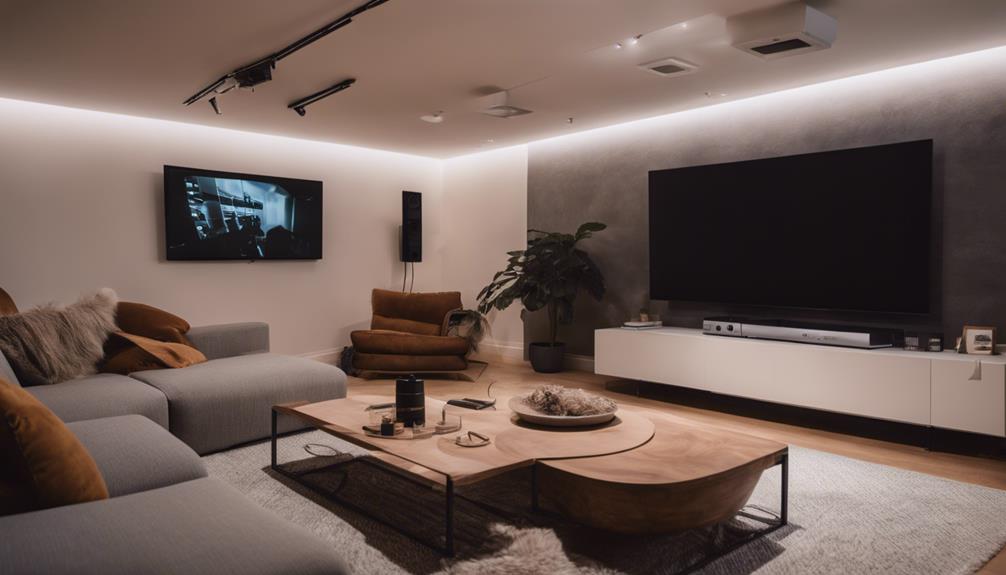
Choosing the right setup for your projector can greatly enhance your viewing experience, so consider the room's layout and available space carefully. The best mounting option—be it ceiling, wall, or shelf—depends on your specific needs and the projector's specifications.
Here are some key recommendations to keep in mind:
- Height: Position your projector at the correct height to guarantee a clear image on the screen—typically 18 to 40 inches for shelf mounts.
- Viewing Angle Flexibility: Utilize vertical lens shift capabilities for better placement flexibility without sacrificing image quality.
- Ventilation: Guarantee at least 5-6 inches of clearance at the back of the projector to prevent overheating and extend its lifespan.
- Safety: Always follow manufacturer guidelines for installation. Heavy projectors require secure fastening for safety and stability.
Frequently Asked Questions
Should I Mount My Projector on the Wall or Ceiling?
You should consider your room layout and projector specifications. Ceiling mounts offer better alignment and stability for brighter images, while wall mounts provide easier access for adjustments. Think about aesthetics and maintenance before deciding.
Where Is the Best Place to Put a Projector?
The best place to put your projector depends on room layout and ceiling height. Ideally, aim for a position that aligns the lens with the screen for maximum image quality and prevents obstructions.
Can I Put My Projector on a Shelf?
Yes, you can put your projector on a shelf, as long as it's securely fastened and at the right height. Just guarantee proper ventilation and consider the projector's brightness for best performance.
How Close to the Ceiling Should a Projector Be?
Imagine a perfectly projected image dancing across your screen. You'd want your projector mounted 18 to 40 inches above the floor, ensuring a clear view, ideal alignment, and plenty of ventilation for a smooth experience.
Conclusion
To sum up, choosing the right mounting option for your projector can greatly enhance your viewing experience.
Did you know that over 70% of home theater enthusiasts prefer ceiling mounts for their sleek look and ideal space usage?
By considering your installation preferences, projector specs, and safety, you can create a setup that not only looks good but also performs well.
So weigh your options and enjoy a better movie night with the perfect projector placement!
Hello, I’m Art, and I’m excited to be a part of the 1Home Theatre Projector team. As a writer, I’m here to contribute my knowledge and insights to help you achieve the ultimate home cinema experience. I understand that making decisions in the world of home entertainment can be complex, and I’m here to simplify the process for you.
